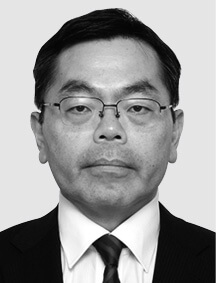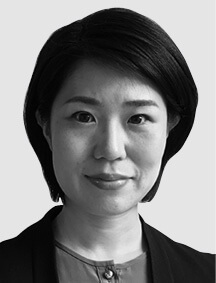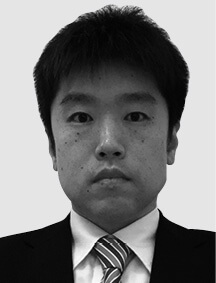Innovation for Next-generation Energy[ⅰ]Power GridsEvolution of Ever-changing Electric Power Systems
Highlight
Power systems are an essential part of the infrastructure that underpins society and need to be kept their vitality despite the inevitable aging and obsolescence of their equipment and technology, and even though the ideal configuration differs from place to place, both in Japan and internationally, for historical as well as other reasons. Along with the potential for use of information and communication technology within the sector, this article also draws on an analogy with the dynamic equilibrium found in living organisms to consider how power systems retain their vitality across generations, describing the Hitachi technologies that are helping this infrastructure avoid ossification and continue to grow dynamically.
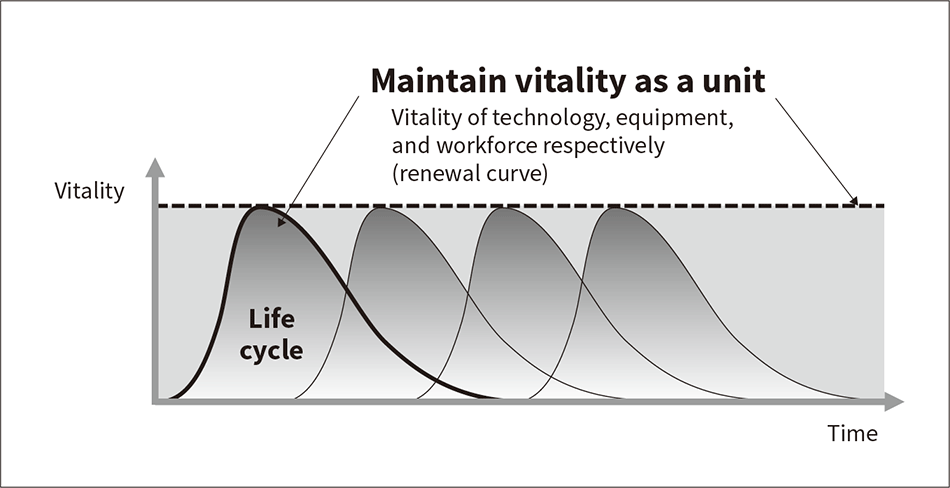
1. Introduction
The severity of natural disasters has prompted questioning of how best to keep society safe and secure. This has led to high expectations being placed on information and communication technology (ICT) as a means for enabling engineering practices that are based on an accurate understanding of physical phenomena and rely on the processing of large quantities of information. By providing the means to process information in ways that would have been unimaginable in the past, the hope is that this will help build a safe and secure society.
Given that ICT is now integral to power systems, Hitachi, too, has been debating how best to leverage this technology to maintain security of supply while also reducing transmission charges, two objectives that appear at first glance to conflict.
To ensure that Hitachi will be able to continue supplying superior capabilities to transmission system operators in the future, this article considers what the ongoing development and maintenance of power systems will entail in the context of a comprehensively thought-out conception of the world.
2. Maintaining and Developing Power System Capabilities
Along with the demographic shift to a falling population, the aging of infrastructure is another issue confronting Japan across all areas of society, not just power systems. The aim is to find the best ways to upgrade this social infrastructure while also improving quality of life (QoL). Looking internationally, the situation is very different to that in Japan, featuring not only rising populations but also large numbers of people who still do not enjoy the benefits of electric power. Some parts of the world still lack an electricity supply. Meanwhile, global warming is only adding to the complexity of the many issues.
Rather than trying to address each of these challenges in isolation, should it not be possible to come up with an ideal power system that delivers a universal and optimal solution to all these different issues? To go straight to the conclusion, it seems wrong to imagine that any such system exists as a ready-made solution just waiting to be deployed, regardless of the societal environment. This is because social infrastructure is heavily dependent on region, history, and customs, such that a universal power system will not necessarily be optimal in its own terms. Even if such a system were implemented, it would be unlikely to remain an ideal solution for long if nothing more was done than to maintain it in its existing state. Such an approach would lead not only to its ossification but also fail to cope with unforeseen factors. This is why, for power systems especially, “action” involving sustained effort by the parties involved is recognized as important for achieving the objective of enhanced QoL.
2.1 Considering Power Systems in Terms of Dynamic Equilibrium
Fig. 1—How to Maintain Vitality through Upgrading of Infrastructure Systems The graph shows, for the case of electric power infrastructure, how the separate functions of technology, equipment, and workforce are maintained by an appropriate process of renewal.
The graph shows, for the case of electric power infrastructure, how the separate functions of technology, equipment, and workforce are maintained by an appropriate process of renewal.
Fig. 2—Relationship between QoL Improvement and Maintenance and Growth of Social Infrastructure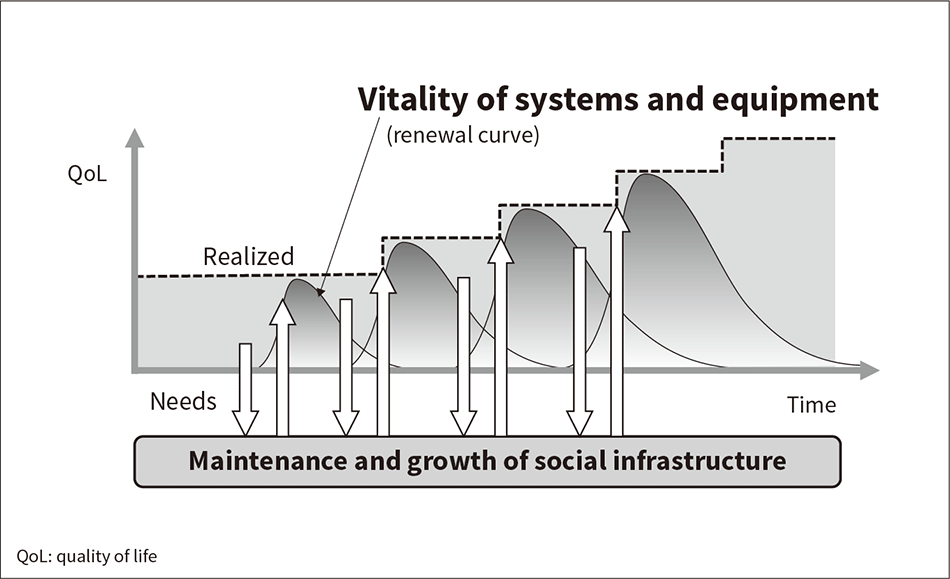 The graph shows, for the case of electric power infrastructure, the process of the electric power infrastructure as it undergoes ongoing maintenance and growth in response to the changing needs of society.
The graph shows, for the case of electric power infrastructure, the process of the electric power infrastructure as it undergoes ongoing maintenance and growth in response to the changing needs of society.
There is no end point for the provision not only of power systems but of social infrastructure generally. System capabilities can only be maintained through an ongoing process of renewal for all of the different equipment and technologies involved. As shown in Figure 1, the capabilities of the overall system are maintained through an ongoing process of replacing the technology, equipment, and workforce components of infrastructure in accordance with their respective life cycles. Furthermore, the people and organizations involved in the construction, upgrading, and maintenance of this infrastructure also go through a process of growth and ongoing organizational renewal through the acquisition of knowledge and skills. To put it in abstract terms, the social infrastructure, while not itself a living entity, can be thought of in biological terms as a “living” system in a state of dynamic equilibrium. In his book, “Seibutsu to Museibutsu no Aida” (Between Organic Matters and Inorganic Matters), Shinichi Fukuoka wrote about systems in dynamic equilibrium, noting that the reason why biological organisms are able to maintain their consistency as living entities, despite being made of matter and subject to the inescapable increase of entropy, is because they are able to metabolize at a rate that outpaces this entropy(1). In Japan, for example, which has achieved a certain level of development when it comes to the provision of power systems, these power systems exist in macro terms as structures that fulfil an ongoing role of delivering electricity to the public. Shift the focus instead to the micro scale of the individual components and technologies that make up these systems and it can be seen that these components are being continually replaced as they are upgraded over time. This is analogous to a system in dynamic equilibrium in that the system as a whole continues to function as a single entity serving a particular purpose while its component parts are in a constant flux of replacement.
In using this analogy to consider the social infrastructure as a single organism, Hitachi recognizes the need for technology development to supply solutions that satisfy the three requirements of: (1) Clarification of the culture (norms and practices) that persists from the past to the future, (2) Successful fusion of digital technology and numerical techniques, and (3) Establishment of an environment that encourages ongoing innovation. Hitachi also sees its own role as being the ongoing supply of solutions that help achieve this.
The field of social infrastructure is experiencing changing circumstances and requirements. Figure 2 shoes how QoL can be enhanced while also meeting these requirements. Furthermore, however much the environment is evolving, these changes are taking place amid the realization of consistent actions and objectives, with the infrastructure systems themselves being run on the basis of criteria that remain unchanged. In power systems, the actions aimed at achieving optimal outcomes within the constraint of maintaining system-wide reliability are expected to take the form of an explicit action plan. The objective for power systems is to provide the public with a reliable supply of electric power. Being a prerequisite for the functioning of other societal systems, interruptions to the electricity supply result in significant social losses. In this modern world of worsening disasters, it seems likely that many people will be conscious of this fact.
On the other hand, however good the cultural norms may be, they are of no use without the means to put them into practice. This makes the successful fusion of digital technology and numerical techniques essential to the provision of adequate capabilities for processing large quantities of information along with appropriate measures for innovation in digital technology. Power systems depend on physical processes and this makes it important to achieve a high-level fusion of not only digital technology but also analogue and numerical techniques for the appropriate analysis and control of physical phenomena.
Meanwhile, the objective of establishing reasonable conditions for the appropriate inter-generational sharing of information along with the changing times makes it important also to create an environment that provides ongoing encouragement for innovation. In traditional performing arts like kabuki, for example, there is a consensus that innovation is essential for preserving tradition. This is an expression of the idea that, even as traditions maintain their characteristics from the past, they risk becoming dated unless they respond to the changing needs of society. In order to maintain “living” power systems, it is important to have a mechanism of utilizing technological progress for ongoing improvement of the capabilities of the overall system while also fighting off the inexorable obsolescence and deterioration of technology and equipment.
The required information and technologies change over time. Not only will the future need suitable ways of managing information while also keeping up with these demands, this will also be important for achieving the active and dynamic equilibrium shown in Figure 2.
2.2 Evolution of Power Systems
Fig. 3—Dynamic Equilibrium and Evolution of Social System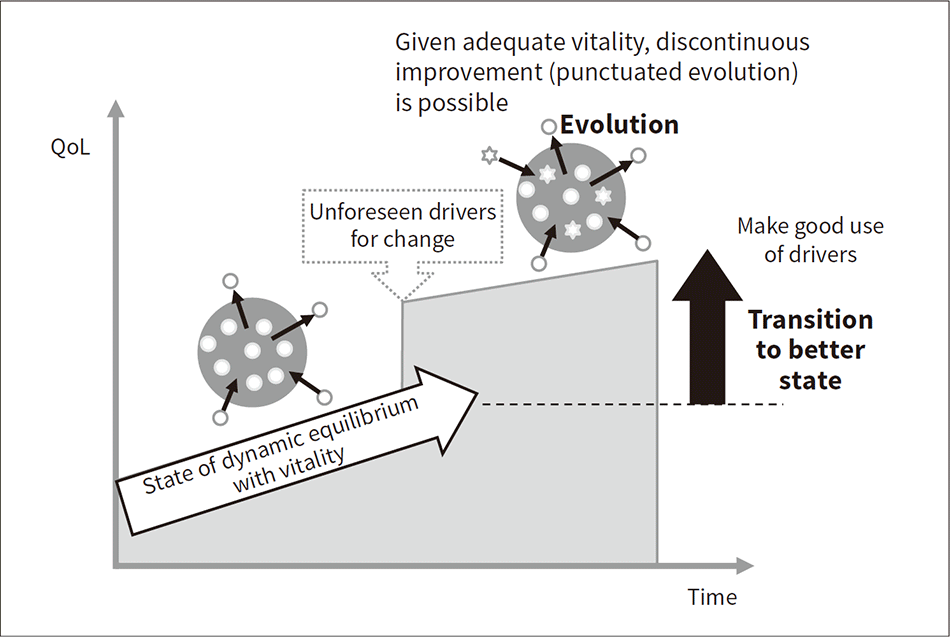 The diagram shows, for the case of electric power infrastructure, how, leveraged by unforeseen drivers, innovative “evolution” proceeds in a way deviated from the extension line of maintenance and growth.
The diagram shows, for the case of electric power infrastructure, how, leveraged by unforeseen drivers, innovative “evolution” proceeds in a way deviated from the extension line of maintenance and growth.
Fig. 4—How Societal System Can Enter Downward Spiral The diagram shows, for the case of electric power infrastructure, how deterioration results from a failure to accommodate unforeseen drivers.
The diagram shows, for the case of electric power infrastructure, how deterioration results from a failure to accommodate unforeseen drivers.
On the subject of “creative evolution,” the French philosopher Henri Bergson argued that living organisms, rather than evolving with a particular end in mind, advance in an indeterminate manner by creative leaps that the organisms themselves are unable to foresee, as expressed in the term élan vital (vital impulse)(2).
Power systems, too, maintain a state of dynamic equilibrium through the ongoing renewal of their equipment and technology. While they may seek as a system to improve themselves, enhancing QoL as they strive to meet the needs of their time, society will still be beset by unforeseeable events. When this happens, a system in an active state of dynamic equilibrium is able to take advantage of these unforeseeable events to transition in a discontinuous manner to an even better state of dynamic equilibrium. This process of discontinuous change can be equated to evolution (see Figure 3).
If, on the other hand, the system lacks dynamism or fails to make good use of the drivers for change, there is also the potential for it to be overcome by the negative impacts of those same drivers and be forced into a downward spiral (see Figure 4).
To avoid this situation, it is likely that techniques will be needed that not only maintain a state of vigorous dynamic equilibrium but are also able to analyze and identify the best methods from among the many possibilities that reside among those drivers for change. This raises the importance of mechanisms that support evolution in cyberspace, where comprehensive options are assumed and each option is digitally evaluated.
To summarize, the concept of digital twins that replicate systems in cyberspace is insufficient on its own to support the evolution of power systems, needing also to be augmented by functions for preemptively assessing selected cases in cyberspace. It is recognized that it will be important for these functions that they not only be capable of the comprehensive simulation of a wide variety of equipment states, but also that they will have the means to support the detailed analysis of performance under various changing conditions.
3. Hitachi Use Cases
3.1 Use Cases that Help Achieve Dynamic Equilibrium
By applying the concepts discussed above to actual projects in the context of current issues, the following sections are intended to serve as practical examples.
3.1.1 Online Optimized Voltage Control
Fig. 5—Overview of OPENVQ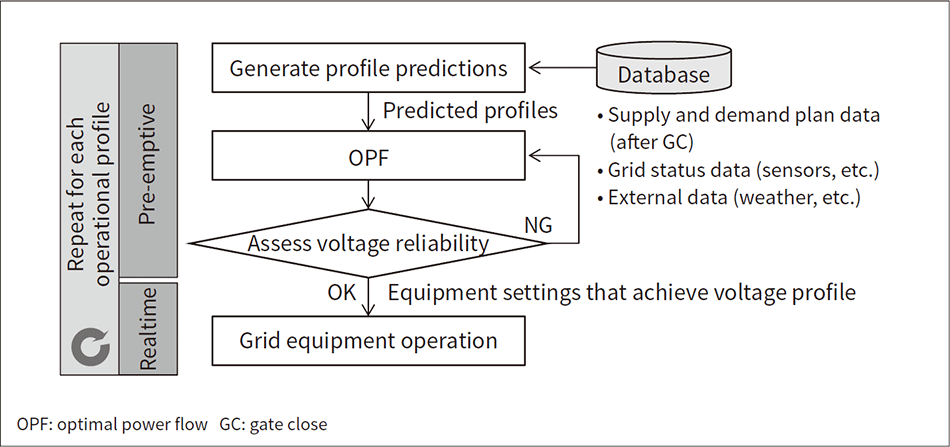 By applying OPF to predicted future grid profiles, OPENVQ calculates the equipment settings that will achieve optimal voltages. These settings are then used on the actual grid equipment.
By applying OPF to predicted future grid profiles, OPENVQ calculates the equipment settings that will achieve optimal voltages. These settings are then used on the actual grid equipment.
In relation to “clarification of the culture (norms and practices) that persists from the past to the future,” Hitachi is using a numerical technique called optimal power flow (OPF) to propose and develop an optimized performance-enabling network for volt/var(Q) (OPENVQ). This is an example of the “cultural” expectation that power systems will maintain reliable operation and deliver optimal outcomes. The system interoperates with the electricity market and utilizes demand prediction to calculate the future state of the entire grid. The predicted grid state is then analyzed using OPF, with repeated calculations being performed to obtain optimal voltage profiles for maintaining reliable operation while also reducing transmission losses. These voltage settings are then used on the actual grid equipment (see Figure 5).
To determine how well the system works and to promote it to customers, Hitachi is also developing an OPENVQ simulator that evaluates system performance in a variety of ways, including its reliability and its economic benefits in terms of maintenance costs and other factors. The simulator incorporates a grid model based on a model of the IEEE 118 bus system. Results from its application to various patterns of supply and demand variation in Japan have demonstrated a potential to reduce transmission losses by up to about 10%(3).
Because of its ability to offer benefits of this order, a proposal to run a demonstration project for OPENVQ at the Electricity Generating Authority of Thailand (EGAT) was in FY2019 agreed to by the New Energy and Industrial Technology Development Organization (NEDO) as part of the “Program to Facilitate Private-Sector-Led Promotion of Low-carbon Technology Overseas.” The demonstration project is intended to evaluate the system’s performance and commercial viability.
3.1.2 Improvements to Power System Maintenance and Inspection
Once in place, equipment starts deteriorating with use. The performance of power systems is maintained by people intervening to upgrade equipment that has deteriorated. As shown in Figure 1, along with the utility of equipment being maintained by performing maintenance over the course of its life cycle, more advanced maintenance inspections are achieved by responding to a changing social environment, trying to improve QoL through better method, and continually adopting new techniques in the field.
Two recent issues affecting maintenance inspections in Japan are the aging of infrastructure and a shrinking workforce due to the aging population and low birthrate. Meanwhile, work is progressing on the application of drones, robots, and artificial intelligence (AI) to infrastructure inspection, taking advantage of faster computer processing and the improved performance and lower price of sensors. It is anticipated that the world of the future will see inspections done by people working alongside a variety of different sensors.
However, the use of AI in infrastructure maintenance inspections is not without challenges. Along with the requirement for wireless or other means to be equipped for transmitting acquired image data, a number of other issues will also need to be overcome for it to be used in actual systems, including a shortage of learning data in the infrastructure sector for the development of AI algorithms.
Hitachi is already working on ways of improving the inspection of electrical equipment, including in the telecommunications sector where it launched a fifth-generation (5G) demonstration project at its Omika Works in September 2019(4). In the development of diagnostic algorithms, it is also drawing on expertise from the industrial sector and elsewhere on improving AI accuracy using only small amounts of learning data. In this way, Hitachi believes that the knowledge and expertise it has acquired from research and development across a wide range of industries and sectors can help with total system optimization in the maintenance inspection workplace.
3.2 Optimal Infrastructure Planning that Encourages Power System Evolution
Fig. 6—State Transition Model of Changes in Grid Configuration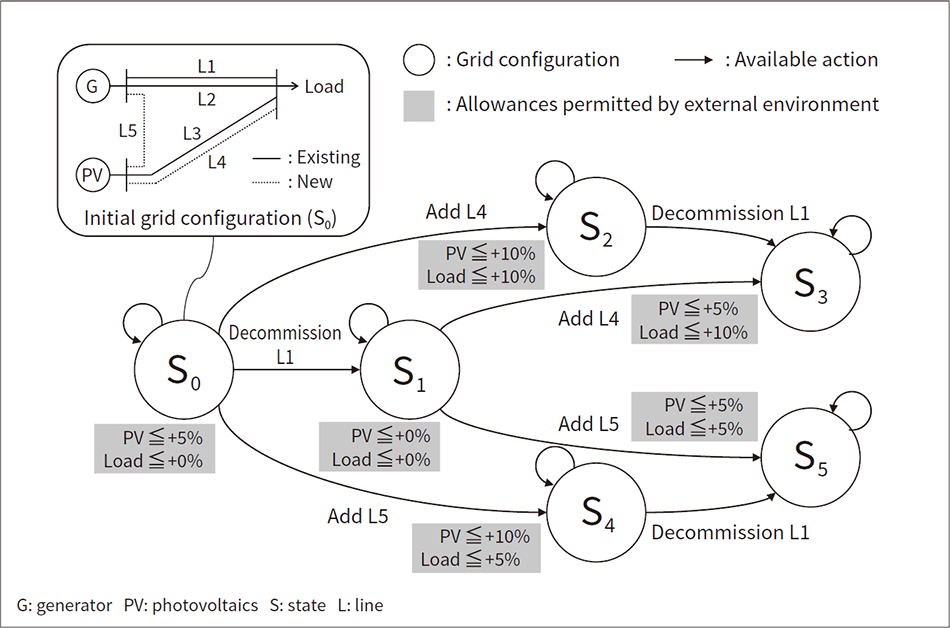 Based on the initial grid configuration and available actions, a state transition model is generated in which the nodes represent grid configurations and the branches represent available actions. By assigning attributes to each node in the form of allowances (values permitted by external environment) determined from a reliability analysis, it is possible to identify the viable transition paths based on changes in the environment.
Based on the initial grid configuration and available actions, a state transition model is generated in which the nodes represent grid configurations and the branches represent available actions. By assigning attributes to each node in the form of allowances (values permitted by external environment) determined from a reliability analysis, it is possible to identify the viable transition paths based on changes in the environment.
Most of Japan’s power system infrastructure was installed during the post-war period of rapid economic growth and is now rapidly aging. Unforeseen changes in the external environment, such as the legal unbundling of transmission and generation, have also been happening over recent years, as represented by the drivers for change in Figure 3. Along with the aging of equipment, future grid planning will also need to take account of various changes in the operating environment. Complicating this is that funding for grid investment will continue to shrink year by year as a result of falling demand. The challenge will be to evolve the power system in a rational manner based on the changing environment in anticipation of selection and concentration whereby unnecessary equipment is decommissioned and necessary equipment is upgraded.
As this is a planning problem involving constraints such as reliability and budget, one way to solve it is through the use of mathematical optimization. Unfortunately, because grid planning requires the analysis of complex branching networks in order to assess power system reliability, applying the problem to one of simple mathematical planning is unrealistic. Meanwhile, given the need to maintain transparency in capital investment, it is believed that, rather than seeking difficult-to-achieve optimal solutions for particular spans, a better approach is to obtain comprehensive solutions that are practically viable so that the choice of plan can then be subject to scrutiny from a variety of perspectives.
In response, Hitachi has devised a planning technique based on a state transition model that represents changes in the grid configuration (see Figure 6). The technique produces a comprehensive set of potential grid configurations over the timespan of the plan based on the available actions such as the upgrading or decommissioning of equipment. These are used to generate a state transition model in which the grid configurations are the nodes and the available actions are the branches. Allowances (values permitted by external environment) determined from a reliability analysis are assigned to each node as attributes, and each branch represents a combination of available actions based on the budget constraint. This can then be used to obtain a comprehensive set of transition paths, meaning the different practically viable processes in which the grid could evolve in response to changes in the environment over the timespan of the plan(5).
4. Conclusions
Investigations have been carried out recently into the use of drones as a more efficient way to perform visual inspections of electricity infrastructure. While drones were not invented for this purpose, this example of their being put to good use can be seen as indicative of the flexibility and utility of the universal culture (norms and practices) followed by the many people involved in power systems.
It is recognized that, along with knowledge that spans generations, a cross-cultural approach is also important for dynamically bringing power systems to a state of equilibrium and sustainable ongoing change. Hitachi believes that Lumada, which creates value from customer data to accelerate digital innovation, will form an important backbone for power system configurations that change dynamically, being able to use advanced digital technology to reach a consensus not only in people’s wisdom but also their thinking.
REFERENCES
- 1)
- S. Fukuoka, “Between Organic Matters and Inorganic Matters,” Kodansha Ltd., Tokyo (May 2007) in Japanese.
- 2)
- H. Bergson, “L’evolution créatrice,” (Creative Evolution), Félix Alcan Éditeur, Paris, (1907) in French.
- 3)
- S. Suenaga et al., “Realization of Online Voltage Profile Optimization,” IEEJ Transactions on Power and Energy, Vol. 139 No. 4 pp. 251–258 (Apr. 2019) in Japanese.
- 4)
- Hitachi News Release, “FANUC, HITACHI, and DOCOMO Launch Joint Study to Assess Advantages of Utilizing 5G to Enhance Manufacturing Sites,” (Sep. 2019) in Japanese.
- 5)
- Y. Okamoto et al., “Research on Planning Support Technology for Reliable and Economical Facility Formation of Social Infrastructure,” The Papers of Technical Meeting on Information Systems, (Aug. 2019) in Japanese.

